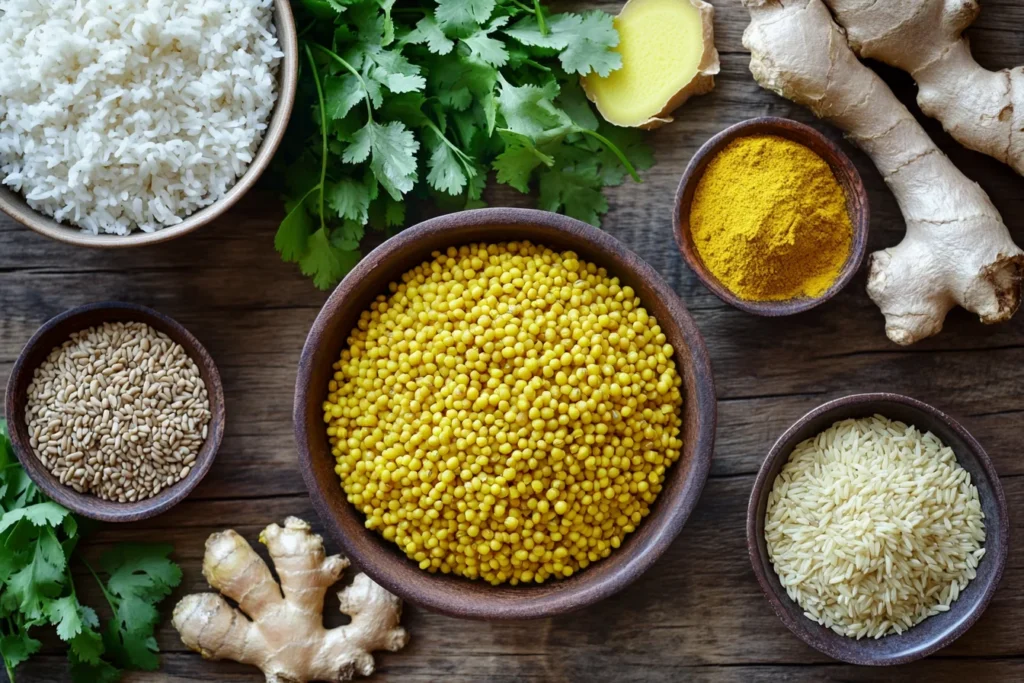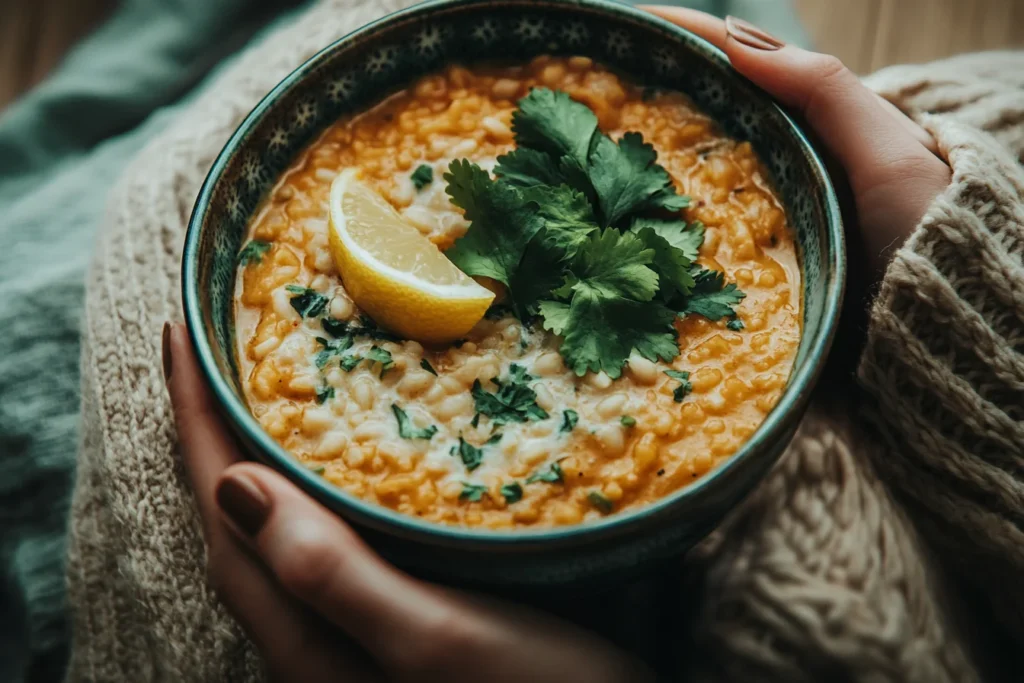Lina: Samad, it’s freezing out my bones need a hug in bowl form.
Samad: I’ve got just the thing: an Ayurvedic Kitchari recipe. It’s basically a warm blanket you can eat.
Lina: Ooh, I’ve heard it’s an Ayurvedic detox meal too, right? Like gentle and grounding?
Samad: Yep, it’s comfort food with healing superpowers. Perfect for Canadian winters or whenever your tummy needs a little TLC.
Table of Contents
What Is Kitchari?
Lina: Okay but real talk what is kitchari? It always sounds so fancy.
Samad: It’s actually the opposite of fancy! Just split mung dal, rice, and spices. Ayurvedic simplicity at its best.
Lina: Ahhh, so like… Indian risotto’s chill cousin?
Samad: Exactly. It’s used in Ayurvedic cleansing diets because it’s super easy to digest, nourishing, and balances all three doshas ata, Pitta, and Kapha.
Lina: You’re basically feeding your gut a hug.
Ingredients You’ll Need For Ayurvedic Kitchari Recipe

Lina: Alright, give me the goods. What do I need to make this Ayurvedic masterpiece?
Samad: It’s pantry-friendly, don’t worry.
- 1/2 cup split yellow mung dal (soaked 2–4 hours)
- 1/2 cup basmati rice
- 1 tbsp ghee (or coconut oil for vegan)
- 1 tsp cumin seeds
- 1 tsp mustard seeds
- 1/2 tsp ground turmeric
- 1/2 tsp ground coriander
- 1/2 tsp grated ginger
- Pinch of asafoetida (optional, but great for digestion)
- 4–5 cups water or veggie broth
- Salt to taste
- Fresh cilantro or lemon juice to finish (optional)
Lina: So simple. It’s like Ayurvedic minimalism.
Samad: And customizable! You can toss in carrots, zucchini, or spinach depending on the season.
Step-by-Step: How to Make Kitchari

Lina: Walk me through this slowly I want to pretend I’m on a retreat in the Himalayas.
Samad: Haha, alright yogi chef. Here we go:
Soak & Rinse
Samad: Soak the mung dal for at least 2 hours this helps with digestion.
Lina: Can I skip it if I’m lazy?
Samad: You can, but your tummy will thank you if you don’t.
Sauté the Spices
Heat your ghee in a heavy-bottomed pot. Add mustard seeds and cumin seeds. Let them pop.
Lina: That popping sound is basically the kitchen saying “I love you.”
Samad: Facts. Then add the ginger, turmeric, coriander, and a pinch of asafoetida.
Add Rice & Dal
Add the rinsed mung dal and basmati rice to the pot. Stir for a minute to toast everything lightly.
Simmer Down Now
Pour in 4–5 cups of water or broth. Add salt. Bring to a boil, then reduce heat and simmer covered for 30–40 minutes.
Lina: Until it’s like thick soup? Or like risotto?
Samad: You can go either way. More liquid for soup vibes. Less for a thicker porridge.
Garnish & Serve
Top with chopped cilantro or a squeeze of lemon juice for brightness.

Why Canadian Families Love It
Lina: Okay this smells like self-care.
Samad: It really is. Especially here in Canada where the cold gets in your bones. This dish warms from the inside out.
Lina: Plus it’s budget-friendly, gluten-free, one-pot, AND freezer-friendly.
Samad: You nailed it. Whether you’re doing an Ayurvedic cleanse or just want a cozy dinner, kitchari fits the bill.
Make It Your Own: Dosha-Friendly Kitchari Variations
Lina: So how do I know if this kitchari matches my dosha?
Samad: Great question! The beauty of Ayurveda is how personalized it can be. Here’s how to tweak the recipe for your dosha:
Vata-Balancing Kitchari
- Add: More ghee, root veggies like carrots and sweet potatoes
- Spices: Add a pinch of cinnamon or nutmeg for warmth
- Texture: Go for a thicker consistency think savoury porridge
Lina: Perfect for those cold, windy fall days in Ontario!
Pitta-Balancing Kitchari
- Add: Zucchini, asparagus, leafy greens
- Spices: Skip the mustard seeds, go easy on the ginger
- Cooling tip: Stir in fresh mint or a spoon of coconut yogurt before serving
Kapha-Balancing Kitchari
- Add: Bitter greens, black pepper, chili flakes
- Spices: Heavier on turmeric, ginger, cumin
- Texture: Go lighter, with more broth think spiced soup
Lina: I love that Ayurveda isn’t one-size-fits-all.
Samad: Exactly! It’s like the meal is actually listening to what your body needs.
Seasonal Kitchari Ideas for Canadian Kitchens
Lina: So what if I want to cook this all year? Do I switch it up with the seasons?
Samad: You totally should. Ayurveda is big on aligning with nature.
Winter
- Add: Roasted squash, extra ghee, warm spices
- Tip: Serve with a spoon of warm chutney or spiced tea
Spring
- Add: Asparagus, kale, fennel
- Tip: Use more bitter and astringent flavours to cleanse
Summer
- Add: Zucchini, cilantro, coconut
- Tip: Lighten the ghee and go easy on heating spices
Fall
- Add: Apples, carrots, ginger
- Tip: Make it thicker and more grounding
Frequently Asked Questions
1. Can I freeze kitchari?
Samad: Absolutely. Let it cool fully, then portion into containers. It’ll last 2–3 months in the freezer.
Lina: Lifesaver for busy weeks!
2. Can I use brown rice instead of basmati?
Samad: You can, but soak it well and cook longer. It’ll be heartier.
Lina: Great if you want more fibre or blood sugar balance.
3. Is this okay for kids?
Lina: Asking for a little picky eater I know…
Samad: Totally kid-safe! Just go light on the spices and make it creamy. Add some peas or carrots for fun.
4. What if I can’t find mung dal in Canada?
Samad: Check your local Indian or South Asian grocer or order online. You can also sub red lentils in a pinch.
Lina: Been there. Red lentils still made a dreamy bowl.
5. Is kitchari only for detoxing?
Samad: Not at all! While it’s a top Ayurvedic detox meal, it’s also great for everyday comfort.
Lina: Like chicken soup for your dosha.
Final Thoughts from the Kitchen
Lina: Alright, I’m officially obsessed. This Ayurvedic kitchari recipe is a total hug in a bowl.
Samad: Whether you’re doing a cleanse or just trying to eat more mindfully, it’s a winner.
Lina: We hope this recipe brings a little joy to your table.
Samad: And don’t forget the best meals are the ones shared with family.
- If you’re looking for something refreshing to sip alongside your cleansing meal, check out these Booster Juice-style smoothies packed with natural energy boosters.
- On cooler days, complement your kitchari with this comforting creamy Thermomix broccoli soup it’s a perfect match for a light detox meal.
- Curious about Canadian superfoods? This haskap syrup recipe is a delicious way to add antioxidant-rich berries to your wellness routine.

Ayurvedic Kitchari
Ingredients
Main Ingredients
- 1/2 cup split yellow mung dal soaked 2–4 hours
- 1/2 cup basmati rice
- 1 tbsp ghee or coconut oil
- 1 tsp cumin seeds
- 1 tsp mustard seeds
- 1/2 tsp turmeric
- 1/2 tsp ground coriander
- 1/2 tsp grated fresh ginger
- asafoetida pinch, optional
- 4-5 cups water or broth
- salt to taste
- fresh cilantro or lemon for garnish (optional)
Instructions
- Soak mung dal for 2–4 hours, rinse well.
- Heat ghee in a pot. Add mustard and cumin seeds until they pop.
- Stir in turmeric, ginger, coriander, and asafoetida.
- Add rice and dal, stir to toast.
- Pour in water or broth and salt. Simmer for 30–40 minutes until creamy.
- Garnish with cilantro or lemon and serve warm.


